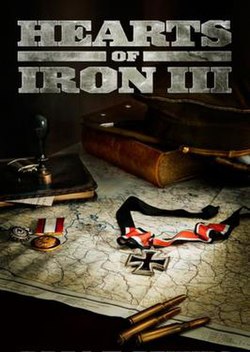Hearts of Iron III
 |
|
| Developer(s) | Paradox Development Studio |
|---|---|
| Publisher(s) | Paradox Interactive |
| Producer(s) | Johan Andersson |
| Designer(s) | Johan Andersson Christopher King |
| Programmer(s) | Thomas Johansson |
| Artist(s) | Jonas Jakobsson Fredrik Toll |
| Composer(s) | Andreas Waldetoft |
| Engine | Clausewitz Engine |
| Platform(s) | Microsoft Windows, OS X |
| Release date(s) |
Microsoft Windows
OS X
|
| Genre(s) | Grand strategy |
| Mode(s) | Single-player, multiplayer |
| Review scores | |
|---|---|
| Publication | Score |
| GameSpot | 8.5/10 |
| IGN | 8.5/10 |
| PC Gamer (UK) | 81/100 |
| PC Zone | 60/100 |
| GamerLimit | 75/100 |
| Smartyweb! | 65/100 |
Hearts of Iron III is a grand strategy wargame developed by Paradox Development Studio and published by Paradox Interactive.
It was released on August 7, 2009. An OS X version was released by Virtual Programming on December 7, 2009.
Hearts of Iron III allows the player to take control of almost any nation that existed during the period of 1936–1948, guiding it through World War II. A variety of decisions regarding the armed forces, production, research, diplomacy, politics and espionage is the focus of the game.
The game centers around three factions: the Axis (led by Germany), the Allies (led by Great Britain), and the Comintern (led by the Soviet Union). All other nations can slowly align with one of the factions. Nations are more likely to side with those with similar ideology, threat and proximity.
Resources found in the game include: energy, metal, rare materials, and oil. The first three are required for industrial production, while oil is converted to fuel for vehicles, planes and ships.
The scope of military organization ranges from brigades to entire theaters of operation.
The first trailer from the Games Convention in Leipzig showed new features such as 3D graphics.
Paradox released a series of developer diaries and video showcases.
Although happy with the scope of Hearts of Iron II, lead designer Johan Andersson wanted to improve upon every aspect of the game, starting again with a new engine. The game's artificial intelligence (AI) was designed to be able to achieve strategic objectives and control forces delegated to it, including whole theatres of operation. The AI can also remember and compare strategic possibilities as circumstances change. Changing to 3D graphics helped improve other areas, as Andersson explained:
...
Wikipedia
